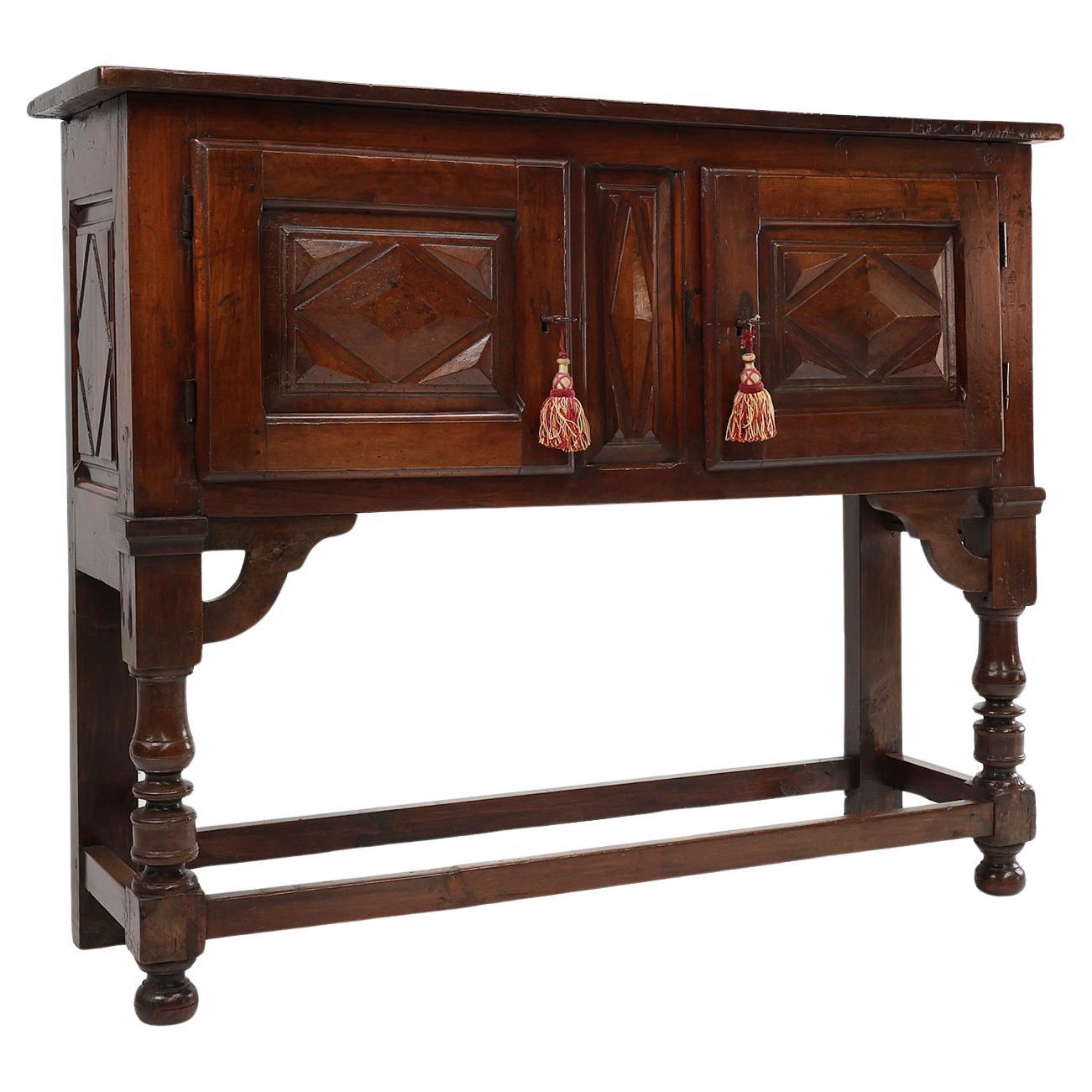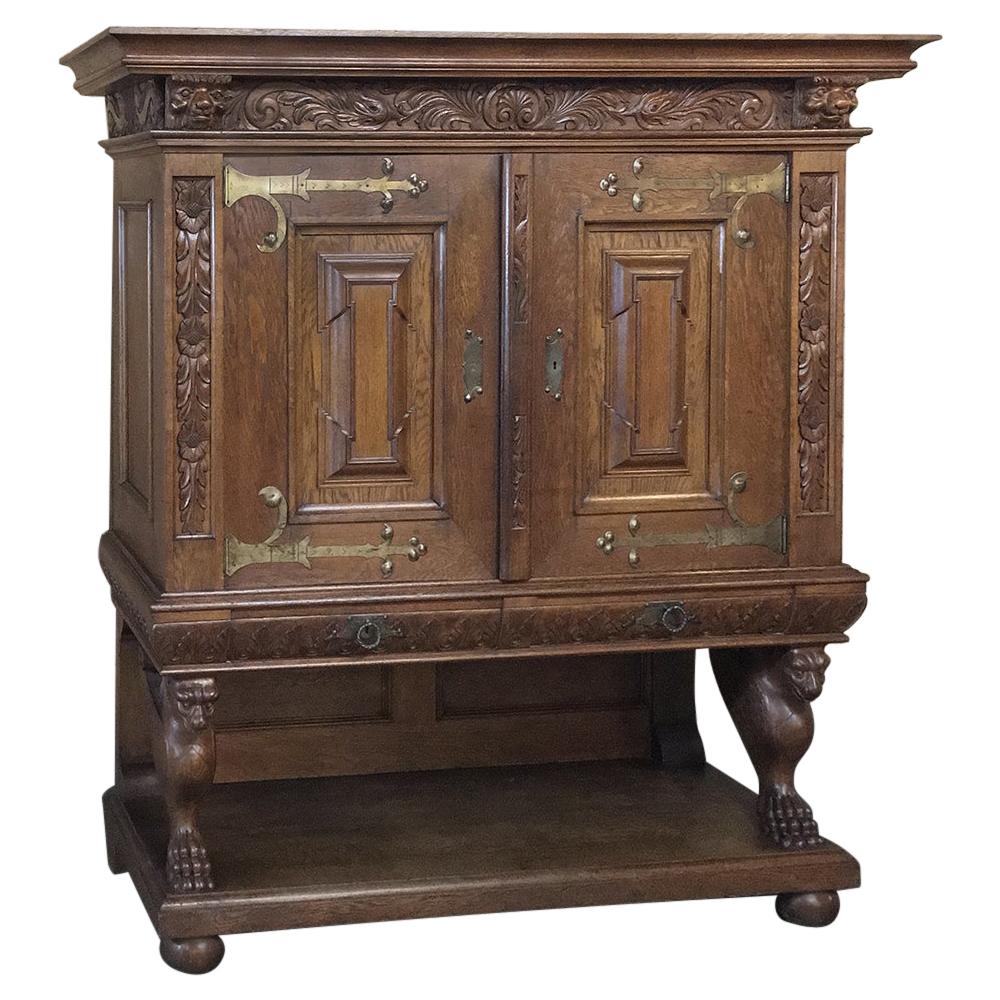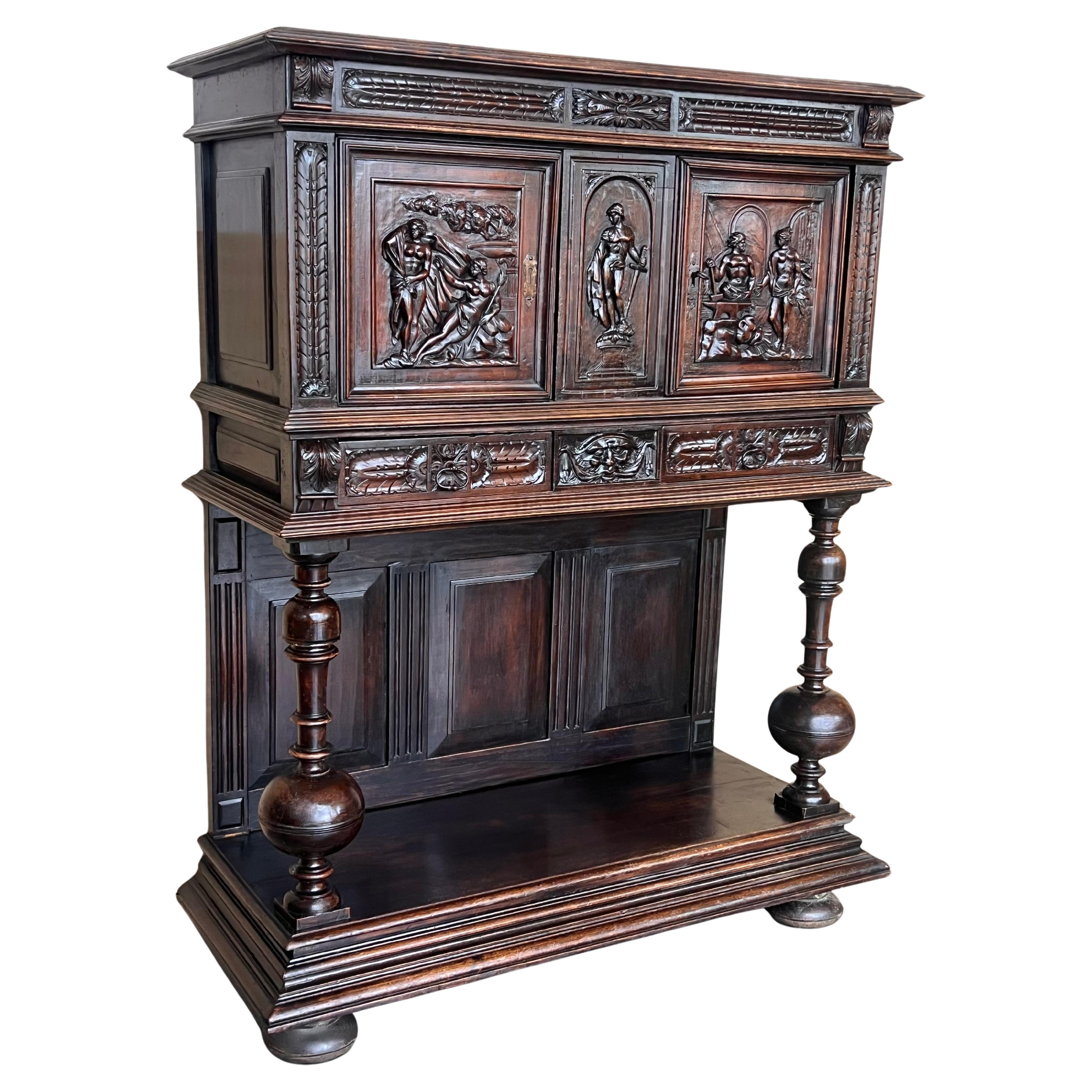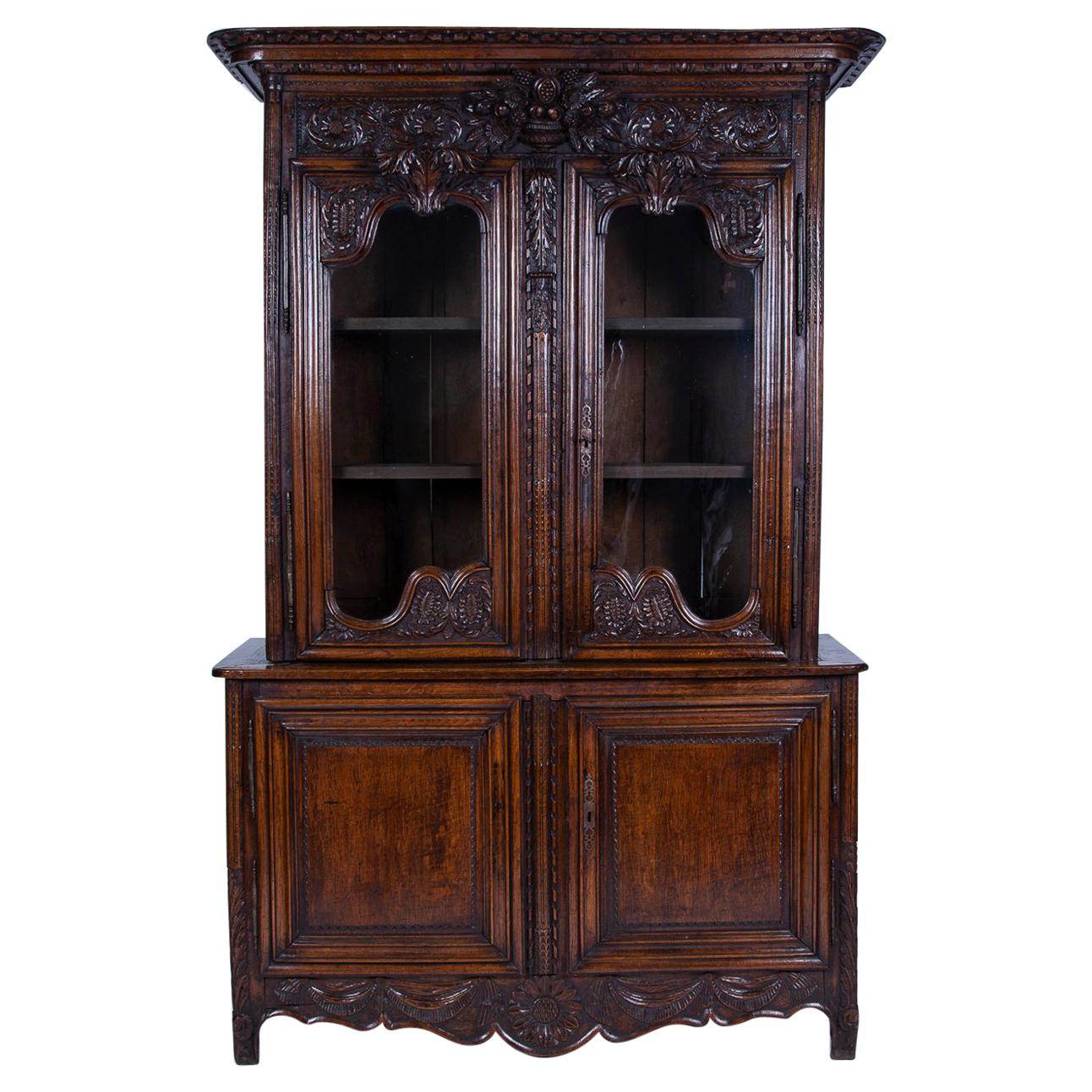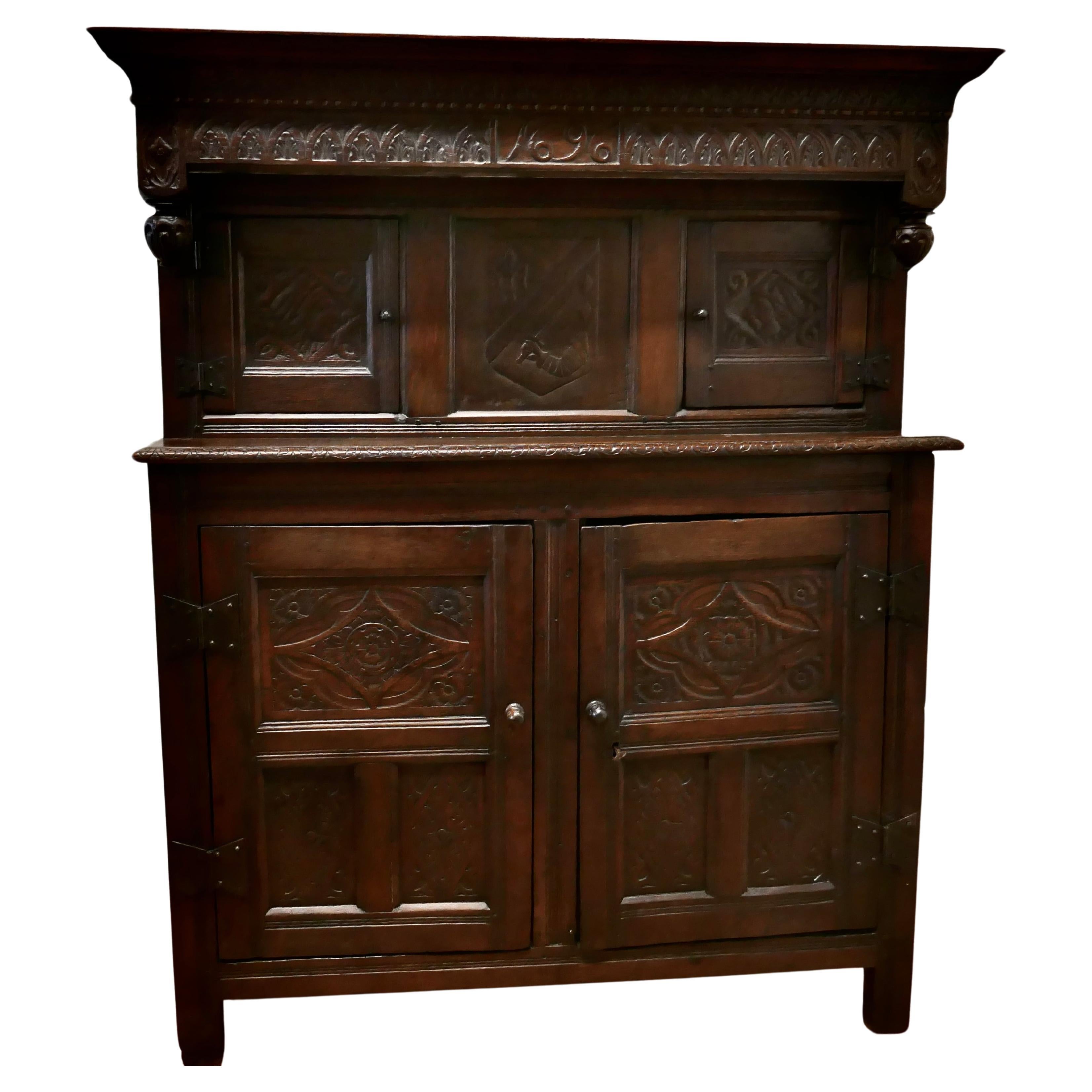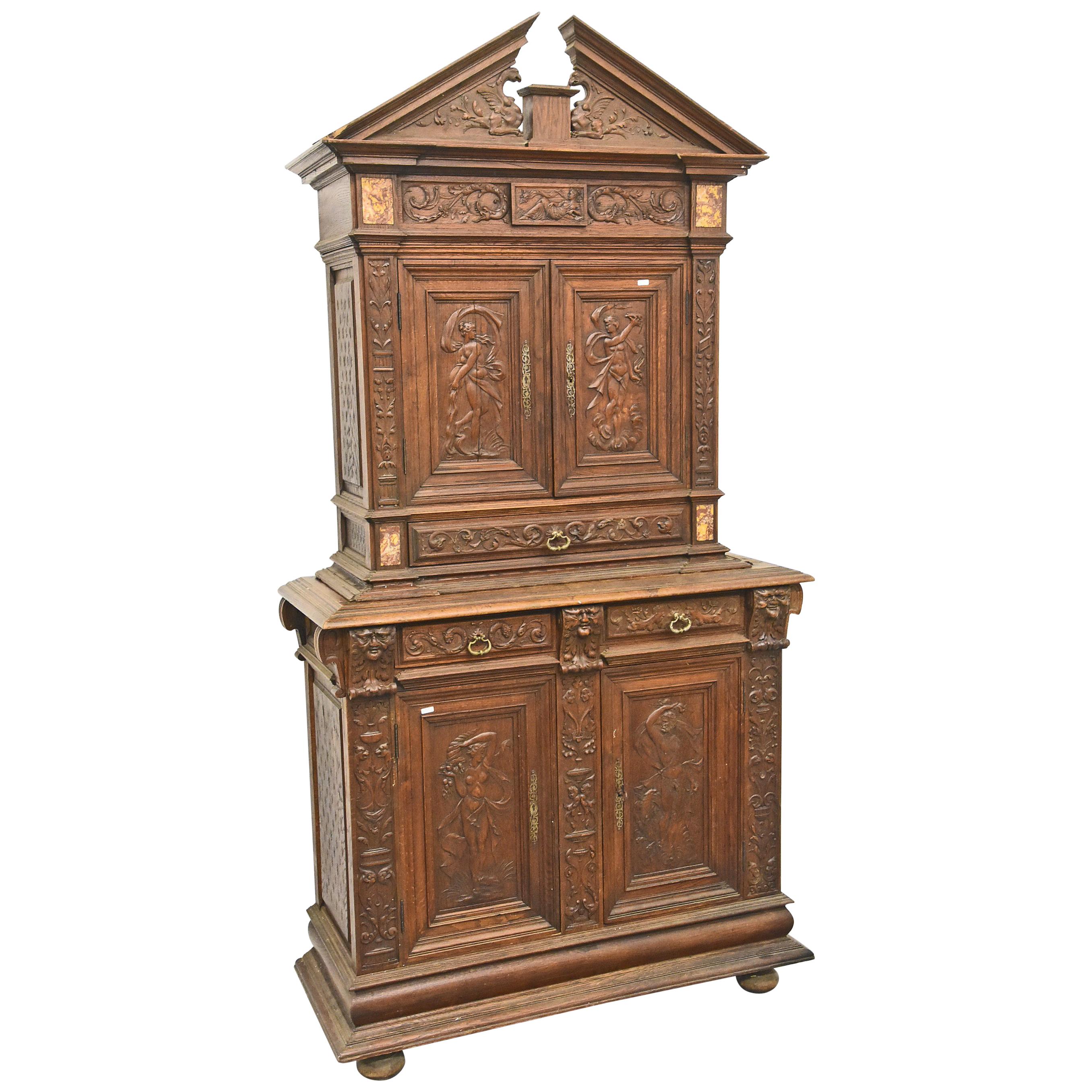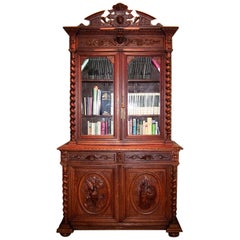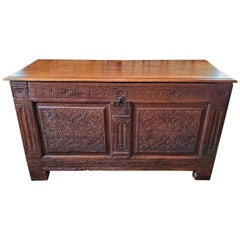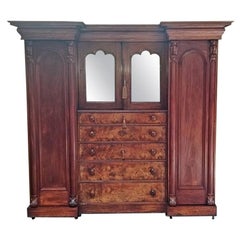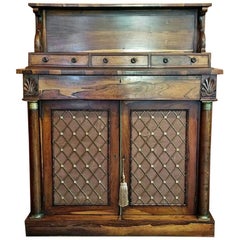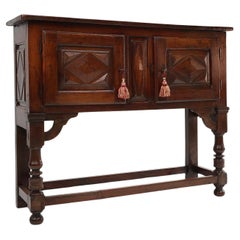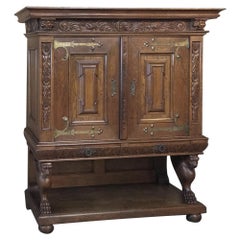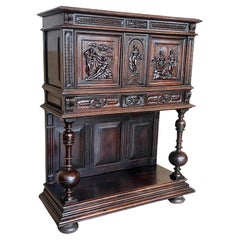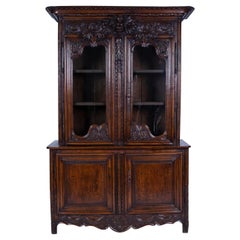Items Similar to Carved Spanish Oak Writing Cabinet, Estate of Vincente Blasco Ibanez
Want more images or videos?
Request additional images or videos from the seller
1 of 19
Carved Spanish Oak Writing Cabinet, Estate of Vincente Blasco Ibanez
$10,000
$12,59920% Off
£7,682.63
£9,679.3520% Off
€8,827.25
€11,121.4620% Off
CA$14,066.24
CA$17,722.0520% Off
A$15,802.79
A$19,909.9320% Off
CHF 8,256.98
CHF 10,402.9720% Off
MX$192,880.43
MX$243,010.0520% Off
NOK 104,839.55
NOK 132,087.3520% Off
SEK 98,684.35
SEK 124,332.4120% Off
DKK 65,872.25
DKK 82,992.4520% Off
About the Item
Presenting an absolutely stunning 16th century carved Spanish oak writing desk and cabinet, with amazing provenance and historical and literary significance.
This desk/cabinet was purchased by a wealthy Dallas family from a French antique auction held at the club room in the Stoneleigh court (hotel), Dallas on Wednesday the 2nd April 1930. (Now the meridian hotel). The auction was titled: “works of art and furnishings of the Chateau de Turique (Nancy) and the Conde-Rougemont home (Touraine). The cover of the catalog also has a seal of a coat of arms. The second page gives a brief description of the auction contents and states that " this exhibition will be presented by M. Fernand M. Adda of Paris France". The desk/cabinet was lot no: 565 and was described in the auction catalog as:
"Carved Spanish writing desk and cabinet...... 16th century period....Upper section a cabinet with two doors which are paneled and display a fine carving. The interior is fitted with eight engraved drawers, and a writing tablet is disclosed in the lower portion. Sustained and central arcade of columns. From Fontana Rosa collection. Supported on four turned legs with bulbous feet."
Fontana Rosa is a historic garden situated on the avenue Blasco Ibáñez in Menton, Alpes-Maritimes, on the French Riviera. The Spanish writer Vicente Blasco Ibanez (1869-1928) began to build it from 1922 on, and he set up home here with his second wife, Elena, and died there in 1928. Vicente Blasco Ibanez was a journalist, politician and best-selling Spanish novelist in various genres whose most widespread and lasting fame in the English-speaking world is from Hollywood films adapted from his works. The provenance is impeccable, it belonged to Ibanez and was part of his collection at Fontana Rosa when he died in 1928.
The auction in which it was first sold in Dallas was in 1930, which makes perfect sense from a 'timeline' point of view. Ibanez is a very important literary figure. Having regard to the fact that this is a writing desk means that in all probability, Ibanez would have 'penned' some of his famous works at this very desk and using the surviving slope/shelf.
Fontana Rosa is a historic garden situated on the Avenue Blasco Ibáñez in Menton, Alpes-Maritimes, on the French Riviera.
The Spanish writer Vicente Blasco Ibáñez (1869-1928) began to build it from 1922 on, and he set up home here with his second wife, Elena, and died there in 1928.
This garden with Spanish and Menton pottery is found in avenue Blasco Ibanez, near Garavan station, and was created a Historical Monument in 1990.
It is also called “Le Jardin des Romanciers” (El Jardín de los Novelistas/The Garden of Novelists), and was frequented by celebrities such as Jean Cocteau. It was the place where Blasco Ibáñez wrote Mare Nostrum, a novel filmed later in 1926.
The garden inspired by Andalusian and Arabian-Persian styles contains species such as Ficus macrophylla, Araucaria heterophylla , palm trees, banana trees or scented rosebushes. It is a tribute to Vicente’s favourite writers : Cervantes, Dickens, Shakespeare or Honoré de Balzac, whose busts can be found at the entrance and to whom he dedicated several fountains and rotundas.
Its main buildings are a small elevated villa with polychromatic pottery which houses a library and a personal movie projector room, and a main house (Villa Emilia) in the lower part of the property that dates from the 19th century. The architectural complex also has an aquarium, a colonnade, a concrete pergola, pillars, flower vases, ceramic-panelled benches around the main house and a big round, steel pergola covering a long staircase in the middle of the property.
After Blasco Ibáñez’s death here, his son inherited the property. In 1939, it was sacked during the war and later abandoned for more than thirty years. Blasco Ibáñez’s son gave it to the commune of Menton in 1970. Since 1985, the buildings have been restored and, as from 1991, the pottery too. Still undergoing restoration, the garden may be visited only by guided tour, on Monday and Friday at 10am.
Vicente Blasco Ibáñez (29 January 1867 – 28 January 1928) was a journalist, politician and best-selling Spanish novelist in various genres whose most widespread and lasting fame in the English-speaking world is from Hollywood films adapted from his works.
He was born in Valencia. At university, he studied law and graduated in 1888 but never went into practice. He was more interested in politics, journalism, literature and women. He was a particular fan of Miguel de Cervantes.
In politics he was a militant Republican partisan in his youth and founded a newspaper, El Pueblo (translated as The People) in his hometown. The newspaper aroused so much controversy that it was taken to court many times. In 1896, he was arrested and sentenced to a few months in prison. He made many enemies and was shot and almost killed in one dispute. The bullet was caught in the clasp of his belt. He had several stormy love affairs.
He volunteered as the proofreader for the novel Noli Me Tangere, in which the Filipino patriot José Rizal expressed his contempt of the Spanish colonization of the Philippines. He travelled to Argentina in 1909 where two new cities, Nueva Valencia and Cervantes, were created. He gave conferences on historical events and Spanish literature. Tired and disgusted with government failures and inaction, Vicente Blasco Ibáñez moved to Paris at the beginning of World War I. When living in Paris, Ibáñez had been introduced to the poet and writer Robert W. Service by their mutual publisher Fisher Unwin, who asked Robert W. Service to act as an interpreter in the deal of a contract concerning Ibáñez.[1]
He was a supporter of the Allies in World War I.
He died in Menton, France in 1928, the day before his 61st birthday, in the residence of Fontana Rosa (also named the House of Writers, dedicated to Miguel de Cervantes, Charles Dickens and Honoré de Balzac) that he built.
Writing career:
His first published novel was “La araña negra” (‘The Black Spider‘) in 1892, an immature work that he later repudiated – a study of the connections between a noble Spanish family and the Jesuits throughout the 19th century. It seems to have been a vehicle for him to express his anti-clerical views.
In 1894, he published his first mature work, a novel called “Arroz y tartana” (Airs and Graces). The story is about a widow in late 19th century Valencia trying to keep up appearances in order to marry her daughters well. His next books consist of detailed studies of aspects of rural life in the farmlands of Valencia – the so-called huerta that the Moorish colonizers had created to grow crops such as rice, vegetables and oranges, with a carefully planned irrigation system in an otherwise arid landscape. The concern with depicting the details of this lifestyle qualifies Blasco Ibáñez as an example of Costumbrismo:
Flor de mayo (1895) (‘Mayflower’)
La barraca (novel) (es) (1898)[2] (‘The Hut’)
Entre naranjos (es) (1900)[3] (‘Between Orange Trees’)
Cañas y barro (es) (1902)[4] (‘Reeds and Mud’)
These works also show the influence of Naturalism which he would most likely have assimilated through reading Émile Zola. The characters in these works are determined by the interaction of heredity, environment and social conditions – race, milieu, et moment – and the novelist is acting as a kind of scientist, drawing out the influences that are acting upon them at any given moment. They are powerful works but are sometimes flawed by heavy-handed didactic elements. For example, in La Barraca, the narrator often preaches the need for these ignorant people to be better-educated. There is also a strong political element – he shows how destructive it is for these poor farm-workers to be fighting each other rather than uniting against their true oppressors – the Church and the land-owners. However, alongside the preaching, there are lyrical and highly detailed accounts of how the irrigation canals are managed and of the workings of the age-old “tribunal de las aguas” – a court composed of farmers that meets weekly close by Valencia Cathedral to decide which farm gets to receive water when and which also arbitrates on disputes on access to water. “Cañas y barro” is often adjudged[citation needed] the masterpiece of this phase of Blasco Ibáñez’s writings.
After that, his writing changed markedly. He left behind costumbrismo and Naturalism and began to set his novels in more cosmopolitan locations than the huertaof Valencia. His plots became more sensational and melodramatic. Academic criticism of him in the English-speaking world has largely ignored these works, although they form by far the majority of his published output – some 30 works. Some of these works attracted the attention of Hollywood studios and became the basis of celebrated films.
Prominent among these is Sangre y arena (es) (Blood and Sand, 1908), which follows the career of Juan Gallardo from his poor beginnings as a child in Seville, to his rise to celebrity as a matador in Madrid, where he falls under the spell of the seductive Doña Sol, which leads to his downfall. Ibáñez directed a 65-minute film version in 1917. There are three remakes made in 1922, 1941 and 1989, respectively.
His greatest personal success probably came from the novel Los cuatro jinetes del Apocalipsis (The Four Horsemen of the Apocalypse) (1916), which tells a tangled tale of the French and German sons-in-law of an Argentinian land-owner who find themselves fighting on opposite sides in the First World War. When this was filmed by Rex Ingram in 1921, it became the vehicle that propelled Rudolph Valentino to stardom.
Rex Ingram also filmed Mare Nostrum – a spy story from 1918 – in 1926 as a vehicle for his wife Alice Terry at his MGM studio in Nice. Michael Powell claimed in his memoirs that he had his first experience of working in films on that production.
A further two Hollywood films can be singled out, as they were the first films that were made by Greta Garbo following her arrival at MGM in Hollywood –The Torrent (based on Entre naranjos from 1900), and The Temptress (derived from La Tierra de Todos from 1922).
We are of the OPINION that this desk/cabinet was originally constructed in the 16th Century in Spain.
The PROVENANCE is IMPECCABLE….it belonged to Vincente Blasco Ibanez and was part of his Collection at Fontana Rosa when he died in 1928.
The Auction in which it was first sold in Dallas was in 1930, which makes perfect sense from a ‘timeline’ point of view.
IBANEZ is a VERY IMPORTANT literary figure. Having regard to the fact that this is a writing desk means that in all probability, Ibanez would have ‘penned’ some of his famous works AT THIS VERY DESK!
CONDITION: We are of the opinion, however, that the desk/cabinet has undergone some significant restoration since it was acquired at Auction in 1930. If one compares the Catalog photograph with the current desk one can clearly see that the base is original and correct, as are the pair of carved doors….but the rest of the piece has been re-purposed or refurbished.
- Dimensions:Height: 54.25 in (137.8 cm)Width: 30.5 in (77.47 cm)Depth: 23 in (58.42 cm)
- Style:Renaissance (Of the Period)
- Materials and Techniques:
- Place of Origin:
- Period:
- Date of Manufacture:1580
- Condition:Repaired: The cabinet has undergone some significant restoration since it was acquired at Auction in 1930. If one compares the Catalog photograph with the current desk one can clearly see that the base is original, as are the 2 doors and Writing Slope. Wear consistent with age and use. Minor losses. Minor structural damages. Restored circa 1930-50. Missing lower drawer. Light Fitting installed circa 1920.
- Seller Location:Dallas, TX
- Reference Number:1stDibs: LU3978111679551
About the Seller
4.9
Vetted Professional Seller
Every seller passes strict standards for authenticity and reliability
Established in 2015
1stDibs seller since 2018
390 sales on 1stDibs
Typical response time: <1 hour
- ShippingRetrieving quote...Shipping from: Dallas, TX
- Return Policy
Authenticity Guarantee
In the unlikely event there’s an issue with an item’s authenticity, contact us within 1 year for a full refund. DetailsMoney-Back Guarantee
If your item is not as described, is damaged in transit, or does not arrive, contact us within 7 days for a full refund. Details24-Hour Cancellation
You have a 24-hour grace period in which to reconsider your purchase, with no questions asked.Vetted Professional Sellers
Our world-class sellers must adhere to strict standards for service and quality, maintaining the integrity of our listings.Price-Match Guarantee
If you find that a seller listed the same item for a lower price elsewhere, we’ll match it.Trusted Global Delivery
Our best-in-class carrier network provides specialized shipping options worldwide, including custom delivery.More From This Seller
View All19th Century French Provincial Highly Carved Oak Hunt Bookcase
Located in Dallas, TX
PRESENTING AN ABSOLUTELY GORGEOUS AND IMPOSING Early 19C French Provincial Highly Carved Oak Bookcase.
French Provincial Oak Bookcase from circa 1840.
Heavily carved, this style is often referred to as being in "Hunt Style", from Northern France and often incorrectly, described as Flemish.
Pelmet heavily carved with Armorial Crest.
The upper section consists of a 2 door glass fronted Bookcase and has Gorgeous barley twist columns to the sides, with 3 interior shelves.
The Base has two doors each with exquisite carvings, one with hanging game birds...
Category
Antique Mid-19th Century French French Provincial Bookcases
Materials
Oak
17th Century English Carved Oak Dowry Chest
Located in Dallas, TX
Presenting an absolutely gorgeous and historic 17th century English carved oak dowry chest.
Made of solid oak in England,...
Category
Antique Early 17th Century English Jacobean Blanket Chests
Materials
Oak
$3,475 Sale Price
50% Off
Early 19th Century British Mahogany Gothic Revival Wardrobe
Located in Dallas, TX
Beautiful early 19th century, circa 1830, William IV Period, mahogany Regency Gothic Revival wardrobe or armoire or linen press with central mirrored tabernacle and 5-drawer chest of...
Category
Antique Early 19th Century English William IV Wardrobes and Armoires
Materials
Mahogany
$3,600 Sale Price
47% Off
18th Century British Regency Bureau Chiffonier in Manner of Gillows
By Gillows of Lancaster & London
Located in Dallas, TX
Fantastic piece in impeccable condition. Regency exotic hardwood bureau or secretaire desk or cabinet of lovely proportions.
From circa 1790. The top portion consists of an open columned pelmet and shelf with a series of drawers underneath. All made of rosewood. The bottom section is a double door cabinet with double shelving inside. The façade of the doors consist of glorious gilded latticework frames with rose shaped connectors and with brown silk blinds...
Category
Antique Late 18th Century English Regency Cabinets
Materials
Rosewood
Late 18C English Regency Corner Wall Cabinet
Located in Dallas, TX
Presenting an important piece of English furniture, namely, a late 18c English regency corner wall cabinet.
What makes this corner wall cabinet so important is the inlaid marquetry medallion in the center of the front door.
The medallion is the ‘Prince of Wales Plumes’ which signifies that this piece was made during the reign of the Prince Regent...
Category
Antique Late 18th Century English Regency Corner Cupboards
Materials
Ebony, Mahogany, Oak, Satinwood
Rare 19C Portois & Fix Viennese Cabinet
By Portois & Fix
Located in Dallas, TX
PRESENTING A STUNNING and RARE 19C Portois & Fix Viennese Cabinet.
Made by the famous and highly desirable maker, ‘Portois & Fix’ in Vienna, Austria ...
Category
Antique Late 19th Century Austrian Belle Époque Cabinets
Materials
Brass, Ormolu
$20,800 Sale Price
46% Off
You May Also Like
Antique 16th century Spanish carved cabinet in oak
Located in Meulebeke, BE
Spain / 16th century / cabinet / oak / Rustic / Antique
A stunning Spanish antique highboard or cabinet in warm oak wood with two doors from the 16th century. The cabinet has its original keys and offers ample storage space behind the doors.
This hand carved antique oak cabinet...
Category
Antique 16th Century Spanish Rustic Cabinets
Materials
Oak
19th Century Dutch Hand Carved Renaissance Raised Cabinet
Located in Dallas, TX
19th century Dutch hand carved Renaissance raised cabinet was rendered from dense, old-growth quarter sawn oak, examples of which are on displa...
Category
Antique Mid-19th Century Dutch Renaissance Revival Wardrobes and Armoires
Materials
Steel
19th Century Dutch Hand Carved Renaissance Raised Cabinet
Located in Miami, FL
20th century Spanish hand carved Renaissance raised cabinet was rendered from dense, old-growth quarter sawn walnut, examples of which are on display in museums across Belgium and Ho...
Category
Antique Late 19th Century Spanish Baroque Cabinets
Materials
Walnut
Carved Oak Cabinet "Cabinet a Deux Corp", Mid-18th Century, French
Located in London, GB
A large French mid-18th century highly carved oak cabinet "cabinet a deux corp", probably made in Normandy.
The upper two-door glazed section contains two shelves. The lower secti...
Category
Antique Mid-18th Century French Cabinets
Materials
Oak
$8,342 Sale Price
30% Off
1696 French Carved Oak Court Cupboard, Cottage size Livery Cupboard
Located in Godshill, Isle of Wight
1696 French Carved Oak Court Cupboard, Cottage size Livery Cupboard
This is a very attractive piece of carved oak furniture, the top section has the da...
Category
Antique 17th Century Dressers
Materials
Oak
Buffet 19th Century Renaissance Style Carved Oak with Inclusion of Marble Plates
Located in Saint-Ouen, FR
Buffet 19th century, Renaissance style carved oak, with inclusion of marble plates
good condition, a panel of a top door is cracked.
Category
Antique Mid-19th Century French Renaissance Cabinets
Materials
Marble
More Ways To Browse
Antique Writing Cabinet
Spanish Library
Small Carved Cabinet
Black Oak Cabinet
Spanish Cabinet
Spanish Oak
Hand Carved Oak Cabinet
Estate Cabinet
Used New Age Cabinets
Carved Antique Oak Cabinet
Antique Cabinet Turned Legs
Old World Cabinet
Hotel Cabinets
Antique Spanish Cabinet
Drawing Storage Cabinet
German Display Case
German Oak Cabinet
Kitchen Cabinet Spanish
